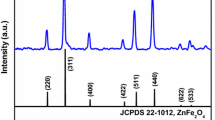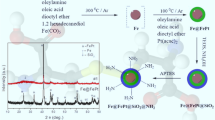Abstract
The adsorption of bovine serum albumin (BSA) protein is important for protein research but remains a great challenge. Here, the hydrothermal method and calcination in a hydrogen-argon mixed atmosphere were used to obtain ordered mono-crystalline magnetic Fe3O4 nanorings with controllable size and uniform structure, which were applied to the adsorption of BSA protein. The results showed that the magnetic Fe3O4 nanorings prepared have the advantages of good crystallinity, controllable morphology, and excellent magnetic response. The Fe3O4 nanorings had an outer diameter of ~160–180 nm, inner diameter of ~80–110 nm, and height of 70 to ~110 nm. The amount of BSA adsorbed by magnetic Fe3O4 nanorings increased with increasing protein concentration; when the concentration of BSA was ~2.75 mg·mL-1 the adsorption amount approached saturation. When the pH value of the solution was ~5, the Fe3O4 nanorings absorption of BSA was greatest. With increasing adsorption time, the amount adsorbed increased gradually. Adsorption equilibrium was reached after 3 h. According to the formula, the saturated adsorption capacity of BSA per gram of magnetic Fe3O4 nanorings was 325.2 mg.

.








Similar content being viewed by others
References
An, N., Zhou, C. H., Zhuang, X. Y., Tong, D. S., & Yu, W. H. (2015). Immobilization of enzymes on clay minerals for biocatalysts and biosensors. Applied Clay Science, 114, 283–296.
Anirudhan, T. S., Rejeena, S. R., & Tharun, A. R. (2012). Preparation, characterization and adsorption behavior of tannin-modified poly (glycidylmethacrylate) grafted zirconium oxide-densified cellulose for the selective separation of bovine serum albumin. Colloid Surface B, 93, 49–58.
Chen, L., Zhou, C. H., Fiore, S., Tong, D. S., Zhang, H., Li, C. S., Ji, S. F., & Yu, W. H. (2016). Functional magnetic nanoparticle/clay mineral nanocomposites: Preparation, magnetism and versatile applications. Applied Clay Science, 127-128, 143–163.
Chen, P., Chen, T., Xie, Q., Xu, L., Liu, H., & Zhou, Y. (2018). Mineralogy and geochemistry of limonite as a weathering product of ilvaite in the Yeshan iron deposit, Tongling, China. Clays and Clay Minerals,66(2), 190–207.
Cortina, M. E., Melli, L. J., Roberti, M., Mass, M., Longinotti, G., & Tropea, S. (2016). Electrochemical magnetic microbeads-based biosensor for point-of-care serodiagnosis of infectious diseases. Biosensors & Bioelectronics, 80, 24–33.
Fuchino, S., Furuse, M., Agatsuma, K., Kamioka, Y., Iitsuka, T., & Nakamura, S. (2014). Development of superconducting high gradient magnetic separation system for medical protein separation. Ieee Transactions on Applied Superconductivity, 24, 1–4.
Galović, O., Samardžić, M., & Sak-Bosnar, M. (2015). A new microsensor for the determination of anionic surfactants in commercial products. International Journal of Electrochemical Science, 10, 5176–5193.
Goiriena-Goikoetxea, M., Guslienko, K. Y., Rouco, M., Orue, I., Berganza, E., & Jaafar, M. (2017). Magnetization reversal in circular vortex dots of small radius. Nanoscale,9, 11269.
Kamioka, Y., Agatsuma, K., Kajikawa, K., Ueda, H., Furuse, M., & Fuchino, S. (2014). Medical protein separation system using high gradient magnetic separation by superconducting magnet. Advances in Cryogenic Engineering: Transactions of the Cryogenic Engineering Conference-CEC. AIP Publishing, 1573, 1129–1134.
Khare, N., Eggleston, C. M., & Lovelace, D. M. (2005). Sorption and direct electrochemistry of mitochondrial cytochrome C on hematite surfaces. Clays and Clay Minerals, 53(6), 564–571.
Liu, X. L., Yang, Y., Ng, C. T., Zhao, L. Y., Zhang, Y., & Bay, B. H. (2015). Magnetic vortex nanorings: a new class of hyperthermia agent for highly efficient in vivo regression of tumors. Advanced Materials, 27, 1939–1944.
Liu, X., Yin, G., Yi, Z., & Duan, T. (2016a). Silk fiber as the support and reductant for the facile synthesis of Ag-Fe3O4 nanocomposites and its antibacterial properties. Materials, 9, 501–509.
Liu, X., Zhu, F. H., & Wang, W. (2016b). Synthesis of single-crystalline iron oxide magnetic nanorings as electrochemical biosensor for dopamine detection. International Journal of Electrochemical Science, 11, 9696–9703.
Magro, M., Baratella, D., Pianca, N., Toninello, A., Grancara, S., & Zboril, R. (2013). Electrochemical determination of hydrogen peroxide production by isolated mitochondria: A novel nanocomposite carbon-maghemite nanoparticle electrode. Sensors and Actuators B: Chemical, 176, 315–322.
Marin, T., Montoya, P., Arnache, O., & Calderon, J. A. (2016). Influence of surface treatment on magnetic properties of Fe3O4 nanoparticles synthesized by electrochemical method. Journal of Physical Chemistry B, 120, 6634–6645.
Nosrati, H., Sefidi, N., Sharafi, A., Danafar, H., & Kheiri, M. H. (2018). Bovine serum albumin (BSA) coated iron oxide magnetic nanoparticles as biocompatible carriers for curcumin-anticancer drug. Bioorganic Chemistry, 76, 501–509.
Pankhurst, Q. A., Connolly, J., Jones, S. K., & Dobson, J. (2003). Applications of magnetic nanoparticles in biomedicine. Journal of Physics D: Applied Physics, 36, R167–RR81.
Ravikumar, R., Chen, L. H., Jayaraman, P., Poh, C. L., & Chan, C. C. (2017). Chitosan-nickel film based interferometric optical fiber sensor for label-free detection of histidine tagged proteins. Biosensors & Bioelectronics, 99, 578–585.
Roh, Y., Zhang, C. L., Vali, H., Lauf, R. J., Zhou, J., & Phelps, T. J. (2003). Biogeochemical and environmental factors in Fe biomineralization: magnetite and siderite formation. Clays and Clay Minerals, 51 (1), 83–95.
Sharafeldin, M., Bishop, G. W., Bhakta, S., El-Sawy, A., Suib, S. L., & Rusling, J. F. (2017). Fe3O4 nanoparticles on graphene oxide sheets for isolation and ultrasensitive amperometric detection of cancer biomarker proteins. Biosensors & Bioelectronics, 91, 359–366.
Sheng, A., Liu, F., Xie, N., & Liu, J. (2016). Impact of proteins on aggregation kinetics and adsorption ability of hematite nanoparticles in aqueous dispersions. Environmental Science & Technology, 50, 2228–2235.
Simard, J. R., Zunszain, P. A., Ha, C. E., Yang, J. S., Bhagavan, N. V., & Petitpas, I. (2005). Locating high-affinity fatty acid-binding sites on albumin by X-ray crystallography and NMR spectroscopy. Proceedings of the National Academy of Sciences USA, 102, 17958–17963.
Sleutels, T. H. J. A., TerHeijne, A., Buisman, C. J. N., & Hamelers, H. V. M. (2012). Bioelectrochemical systems: an outlook for practical applications. Chemsuschem, 5, 1012–1019.
Takahashi, M., Akiyama, Y., Ikezumi, J., Nagata, T., Yoshino, T., & Iizuka, A. (2009). Magnetic separation of melanoma-specific cytotoxic T lymphocytes from a vaccinated melanoma patient's blood using MHC/Peptide complex-conjugated bacterial magnetic particles. Bioconjugate Chemistry, 20, 304–309.
Turner, A. P. (2013). Biosensors: sense and sensibility. Chemical Society Reviews, 42, 3184–3196.
Vigo-Cotrina, H., & Guimarães, A. P. (2018). Writing and storing information in an array of magnetic vortex nanodisks using their azimuthal modes. Journal of Magnetism & Magnetic Materials, 460 (C), 160–164.
Wei, W., Ma, P., Dong, H., Krause, H. J., Zhang, Y., & Willbold, D. (2016). A magnetic nanoparticles relaxation sensor for protein-protein interaction detection at ultra-low magnetic field. Biosensors & Bioelectronics, 80, 661–665.
Yang, Q., Zhu, Y., Yang, M., Ma, S., Wu, Y., & Lan, F. (2016). Ligand-free Fe3O4/CMCS nanoclusters with negative charges for efficient structure selective protein adsorption. Small, 12, 2344–2353.
Yu, W. H., Li, N., Tong, D. S., Zhou, C. H., Lin, C. X., & Xu, C. Y. (2013). Adsorption of proteins and nucleic acids on clay minerals and their interactions: A review. Applied Clay Science, 80-81, 443–452.
Zhu, C. H., Shen, H. B., Xu, R. Y., Wang, H. Y., & Han, J. M. (2007). Adsorption of bovine serum albumin onto magnetic chitosan microspheres. Acta Physico-Chimica Sinica, 23, 1583–1588.
Zhou, C. H., & Keeling, J. (2013). Fundamental and applied research on clay minerals: From climate and environment to nanotechnology. Applied Clay Science, 74, 3–9.
Zhou, C. H., Zhao, L. Z., Wang, A. Q., Chen, T. H., & He, H. P. (2016). Current fundamental and applied research into clay minerals in China. Applied Clay Science, 119, 3–7.
Acknowledgements
This work was supported by the Scientific Research Fund of Sichuan Provincial Education Department (17ZA0401), Fundamental Science on Nuclear Wastes and Environmental Safety Laboratory (15kffk05), Sichuan Science and Technology Program (2018JY0315), China Postdoctoral Science Foundation (2018M633411) and Research Support Program for Longshan Academic Talents (18LZX673), National Natural Science Foundation of China (41872039 and 41831285), and the One-Thousand-Talents Scheme in Sichuan Province, Sichuan Science and Technology Program(2018JY0462).
Author information
Authors and Affiliations
Corresponding authors
Additional information
This paper was originally presented during the World Forum on Industrial Minerals, held in Qing Yang, China, October 2018.
Rights and permissions
About this article
Cite this article
Liu, X., Zhang, Y., Bian, L. et al. Synthesis of Magnetic Fe3O4 Nanorings for BSA Protein Adsorption. Clays Clay Miner. 67, 275–282 (2019). https://doi.org/10.1007/s42860-019-00026-z
Published:
Issue Date:
DOI: https://doi.org/10.1007/s42860-019-00026-z




